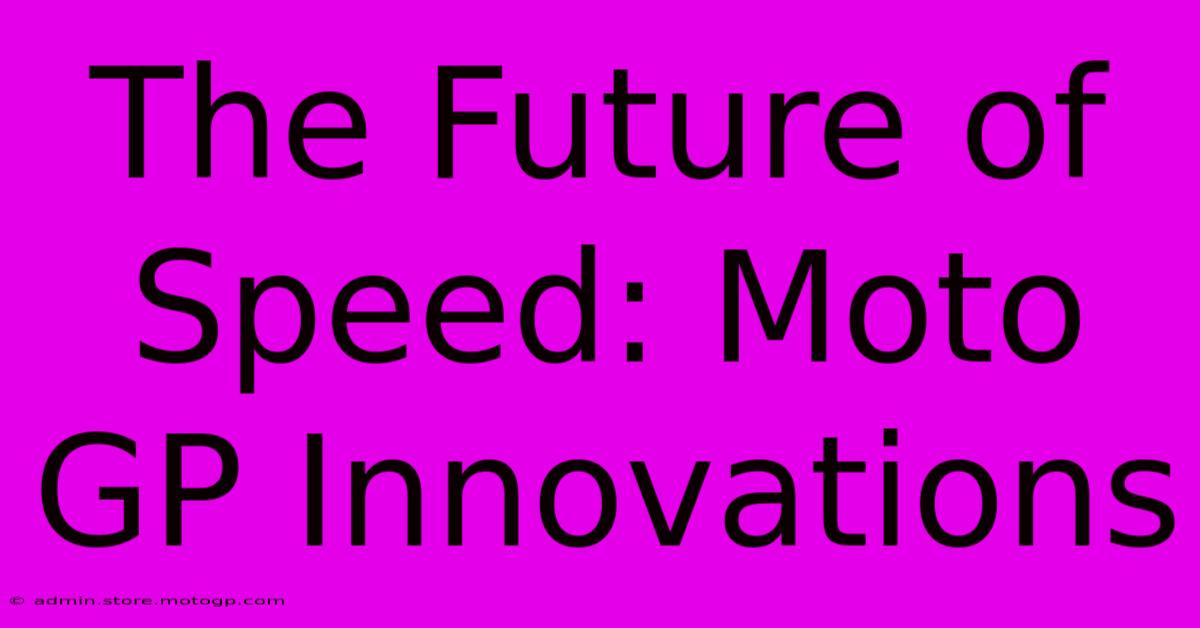The Future Of Speed: Moto GP Innovations

Table of Contents
The Future of Speed: MotoGP Innovations
MotoGP, the pinnacle of motorcycle racing, isn't just about screaming engines and breathtaking speeds; it's a relentless pursuit of innovation. Every season brings advancements in technology, pushing the boundaries of what's possible on two wheels. This article dives deep into the exciting innovations shaping the future of speed in MotoGP.
Aerodynamics: The Unsung Hero of Speed
Aerodynamics play a crucial role in MotoGP. Minimizing drag and maximizing downforce are key to achieving higher speeds and improved cornering. We've seen a dramatic evolution in wing designs, from rudimentary winglets to complex, multi-element systems.
The Evolution of Wings:
- Early Days: Simple winglets primarily focused on reducing wheelies.
- Modern Era: Sophisticated, multi-element wings generating significant downforce, allowing for higher cornering speeds and improved stability.
- Future Trends: We can expect further refinement of wing designs, potentially incorporating active aerodynamic systems that adjust based on track conditions and speed. Computational Fluid Dynamics (CFD) simulations are playing an increasingly important role in optimizing these designs.
Electronics: The Brain of the Beast
Modern MotoGP bikes are essentially sophisticated computers on wheels. Advanced electronics manage everything from traction control and engine braking to launch control and wheelie mitigation.
Cutting-Edge Electronics:
- IMU (Inertial Measurement Unit): This sensor suite provides real-time data on bike lean angle, acceleration, and gyroscopic forces, enabling sophisticated electronic control systems.
- Traction Control: Prevents wheelspin, maximizing acceleration and improving rider safety.
- Engine Braking Control: Manages engine braking, preventing lockups and improving stability under braking.
- Future Advancements: Expect to see even more sophisticated algorithms and machine learning techniques used to optimize rider performance and safety. Adaptive control systems that learn a rider's style are also on the horizon.
Engine Technology: The Heart of the Matter
The heart of any MotoGP bike is its engine. Continuous refinement of engine technology delivers more power and improved efficiency.
Engine Innovations:
- Increased Engine Capacity: While regulations change, the push for more power and higher rev limits remain constant.
- Material Science Advancements: Lighter and stronger materials are crucial for improving performance and reliability.
- Fuel Efficiency: Despite the focus on power, fuel efficiency is also vital, leading to innovative combustion strategies and fuel injection systems.
- Sustainable Fuels: The future of MotoGP will likely involve a transition to more sustainable fuels, reducing the environmental impact of racing.
Tire Technology: The Grip Factor
Tires are the critical link between the bike and the track. Advances in tire technology directly impact speed and performance.
Tire Advancements:
- Advanced Rubber Compounds: New compounds provide superior grip and durability, crucial for maximizing cornering speeds.
- Tire Construction: Innovations in tire construction are improving consistency and performance across varying track conditions.
- Data-Driven Development: Tire manufacturers use vast amounts of data to understand tire behavior and optimize designs for specific tracks and conditions.
- Future Goals: Expect further improvements in tire life and consistency, with a focus on reducing tire degradation during a race.
Rider Training and Data Analysis: Human Element
While technology is crucial, the human element remains central to MotoGP. Rider training and data analysis are becoming increasingly sophisticated.
Advanced Training Techniques:
- Simulators: Sophisticated simulators allow riders to practice and refine their skills in a safe and controlled environment.
- Data Analysis: Detailed analysis of telemetry data allows riders and teams to identify areas for improvement and optimize bike setup.
- Future Trends: Expect to see a greater integration of virtual reality and machine learning in rider training, providing personalized feedback and optimizing performance.
The future of speed in MotoGP is bright. Continuous innovation in aerodynamics, electronics, engine technology, tire development, and rider training will push the limits of what's possible, delivering even more thrilling races for years to come. The evolution never stops, and the quest for speed continues.

Thank you for visiting our website wich cover about The Future Of Speed: Moto GP Innovations. We hope the information provided has been useful to you. Feel free to contact us if you have any questions or need further assistance. See you next time and dont miss to bookmark.
Featured Posts
-
Cota Track Day Conquer Your Fears
Feb 18, 2025
-
Sprint Race Schedule At A Glance
Feb 18, 2025
-
Nbc Moto Gp The Riders Perspective
Feb 18, 2025
-
Sprint Races The Evolution Of Moto Gp
Feb 18, 2025
-
Choosing The Right Circuit Race For You
Feb 18, 2025
